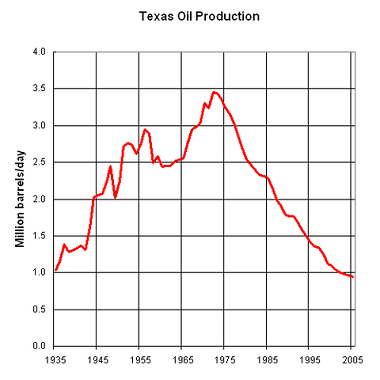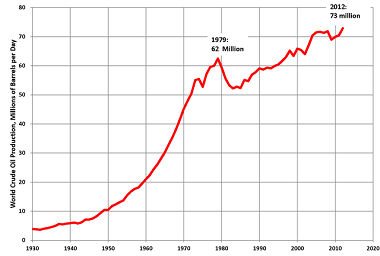Peak oil: Difference between revisions
J.williams (talk | contribs) m (1 revision imported) |
No edit summary |
||
| Line 1: | Line 1: | ||
[[Category:Done 2015- | [[Category:Done 2015-09-06]] | ||
[[File:480px-Texas_Oil_Production_1935_to_2005.png|400px|framed|right|Figure 1. In some places, the peak point for oil production is very obvious. This is the case in the above graph of oil production in Texas.<ref>Wikimedia Commons. (June 30, 2015). ''Texas Oil Production'' [Online]. Available: https://commons.wikimedia.org/wiki/File:Texas_Oil_Production_1935_to_2005.png#/media/File:Texas_Oil_Production_1935_to_2005.png</ref>]] | [[File:480px-Texas_Oil_Production_1935_to_2005.png|400px|framed|right|Figure 1. In some places, the peak point for oil production is very obvious. This is the case in the above graph of oil production in Texas.<ref>Wikimedia Commons. (June 30, 2015). ''Texas Oil Production'' [Online]. Available: https://commons.wikimedia.org/wiki/File:Texas_Oil_Production_1935_to_2005.png#/media/File:Texas_Oil_Production_1935_to_2005.png</ref>]] | ||
<onlyinclude>'''Peak oil''' is the predicted event, based off of the theory of [[Hubbert's peak]], when the maximum rate of extraction and production of [[oil]] is reached. After this point, production will fall continually over time.</onlyinclude><ref>Financial Times. (June 29, 2015). ''Definition of Peak Oil'' [Online]. Available: http://lexicon.ft.com/Term?term=peak-oil</ref> This peak exists for oil because of the steady exponential growth in the rate of use of oil while the overall amount of oil worldwide is depleted. Although this event is frequently discussed in terms of oil as a [[resource]], there exists a peak point for all non-renewable resources (including resources that have little to do with [[energy]] like naturally occurring diamonds or gold). Overall, the production of a finite resource tends to follow a bell shaped curve, with the peak occurring where around half of the resource has been extracted. In theory, this holds true for a single well, oil field, region, and even the world.<ref name="RE1">Peak Oil. (June 30, 2015). ''Peak Oil News'' [Online]. Available: http://peakoil.com/what-is-peak-oil</ref> Note that real production rates are far bumpier than the bell shaped curves produced by simple theories. | <onlyinclude>'''Peak oil''' is the predicted event, based off of the theory of [[Hubbert's peak]], when the maximum rate of extraction and production of [[oil]] is reached. After this point, production will fall continually over time.</onlyinclude><ref>Financial Times. (June 29, 2015). ''Definition of Peak Oil'' [Online]. Available: http://lexicon.ft.com/Term?term=peak-oil</ref> This peak exists for oil because of the steady exponential growth in the rate of use of oil while the overall amount of oil worldwide is depleted. Although this event is frequently discussed in terms of oil as a [[resource]], there exists a peak point for all non-renewable resources (including resources that have little to do with [[energy]] like naturally occurring diamonds or gold). Overall, the production of a finite resource tends to follow a bell shaped curve, with the peak occurring where around half of the resource has been extracted. In theory, this holds true for a single well, oil field, region, and even the world.<ref name="RE1">Peak Oil. (June 30, 2015). ''Peak Oil News'' [Online]. Available: http://peakoil.com/what-is-peak-oil</ref> Note that real production rates are far bumpier than the bell shaped curves produced by simple theories. | ||
| Line 5: | Line 5: | ||
The prediction made by Hubbert was mostly correct, even with new supplies from Alaska and the Gulf of Mexico, production of oil in the United States peaked initially in 1970 (with a slight jump with production of oil in Alaska), and production is currently declining.<ref name=boyle>G.Boyle, B.Everett, S.Peake, J.Ramage. (June 30, 2015). ''Energy Systems and Sustainability: Power for a Sustainable Future'', 2nd Ed. Oxford, UK: Oxford University Press, 2012</ref> Predictions were first made for the United States, but similar predictions can be applied worldwide. However, modelling the entire world and making predictions is a difficult task as many companies are secretive about the amount of oil in their reserves. | The prediction made by Hubbert was mostly correct, even with new supplies from Alaska and the Gulf of Mexico, production of oil in the United States peaked initially in 1970 (with a slight jump with production of oil in Alaska), and production is currently declining.<ref name=boyle>G.Boyle, B.Everett, S.Peake, J.Ramage. (June 30, 2015). ''Energy Systems and Sustainability: Power for a Sustainable Future'', 2nd Ed. Oxford, UK: Oxford University Press, 2012</ref> Predictions were first made for the United States, but similar predictions can be applied worldwide. However, modelling the entire world and making predictions is a difficult task as many companies are secretive about the amount of oil in their reserves. | ||
At this point, the bigger concern is for the environmental consequences of [[climate change]] from [[combustion|burning]] this oil than actually running out of oil. Time Magazine did a good piece on this [http://science.time.com/2013/05/15/the-iea-says-peak-oil-is-dead-thats-bad-news-for-climate-policy/ here]. See [[consequences of climate change]] for more information on why the climate consequences are so disconcerting. | At this point, the bigger concern is for the environmental consequences of [[climate change]] from [[combustion|burning]] this oil than actually running out of oil. Time Magazine did a good piece on this [http://science.time.com/2013/05/15/the-iea-says-peak-oil-is-dead-thats-bad-news-for-climate-policy/ here]. See [[consequences of climate change]] for more information on why the [[climate]] consequences are so disconcerting. | ||
==Unconventional Sources== | ==Unconventional Sources== | ||
| Line 12: | Line 12: | ||
One of the biggest issues with peak oil is that currently there is no answer or solution to the problem. Today the world consumes about four times as much oil as it discovers, thus oil is continually running out.<ref name="RE1"/> Many argue that [[unconventional resource|unconventional sources of oil]] will be the answer to peak oil because of the enormous [[reserve]]s of this unconventional oil worldwide. However, the issue with unconventional oil is that it can be more expensive, time-consuming, and difficult to extract this oil. | One of the biggest issues with peak oil is that currently there is no answer or solution to the problem. Today the world consumes about four times as much oil as it discovers, thus oil is continually running out.<ref name="RE1"/> Many argue that [[unconventional resource|unconventional sources of oil]] will be the answer to peak oil because of the enormous [[reserve]]s of this unconventional oil worldwide. However, the issue with unconventional oil is that it can be more expensive, time-consuming, and difficult to extract this oil. | ||
Through enhanced oil recovery, it is possible to obtain more oil out of existing [[oil and gas reservoir|reservoirs]]. Additionally, extraction of oil from [[oil sands]] is becoming more and more prominent. The advancement of technologies that allow oil to be extracted in these ways could work to increase the size of oil reserves.<ref name=boyle/> Additionally, there is large potential for synthetic gas-to-liquids fuels and coal-to-liquids fuels that could provide an answer to peak oil. | Through enhanced oil recovery, it is possible to obtain more oil out of existing [[oil and gas reservoir|reservoirs]]. Additionally, extraction of oil from [[oil sands]] is becoming more and more prominent. The advancement of technologies that allow oil to be extracted in these ways could work to increase the size of oil reserves.<ref name=boyle/> Additionally, there is large potential for synthetic gas-to-liquids fuels and [[coal]]-to-liquids fuels that could provide an answer to peak oil. | ||
==References== | ==References== | ||
{{reflist}} | {{reflist}} | ||
[[Category:Uploaded]] | [[Category:Uploaded]] | ||
Revision as of 18:17, 4 September 2015

Peak oil is the predicted event, based off of the theory of Hubbert's peak, when the maximum rate of extraction and production of oil is reached. After this point, production will fall continually over time.[2] This peak exists for oil because of the steady exponential growth in the rate of use of oil while the overall amount of oil worldwide is depleted. Although this event is frequently discussed in terms of oil as a resource, there exists a peak point for all non-renewable resources (including resources that have little to do with energy like naturally occurring diamonds or gold). Overall, the production of a finite resource tends to follow a bell shaped curve, with the peak occurring where around half of the resource has been extracted. In theory, this holds true for a single well, oil field, region, and even the world.[3] Note that real production rates are far bumpier than the bell shaped curves produced by simple theories.
The prediction made by Hubbert was mostly correct, even with new supplies from Alaska and the Gulf of Mexico, production of oil in the United States peaked initially in 1970 (with a slight jump with production of oil in Alaska), and production is currently declining.[4] Predictions were first made for the United States, but similar predictions can be applied worldwide. However, modelling the entire world and making predictions is a difficult task as many companies are secretive about the amount of oil in their reserves.
At this point, the bigger concern is for the environmental consequences of climate change from burning this oil than actually running out of oil. Time Magazine did a good piece on this here. See consequences of climate change for more information on why the climate consequences are so disconcerting.
Unconventional Sources

One of the biggest issues with peak oil is that currently there is no answer or solution to the problem. Today the world consumes about four times as much oil as it discovers, thus oil is continually running out.[3] Many argue that unconventional sources of oil will be the answer to peak oil because of the enormous reserves of this unconventional oil worldwide. However, the issue with unconventional oil is that it can be more expensive, time-consuming, and difficult to extract this oil.
Through enhanced oil recovery, it is possible to obtain more oil out of existing reservoirs. Additionally, extraction of oil from oil sands is becoming more and more prominent. The advancement of technologies that allow oil to be extracted in these ways could work to increase the size of oil reserves.[4] Additionally, there is large potential for synthetic gas-to-liquids fuels and coal-to-liquids fuels that could provide an answer to peak oil.
References
- ↑ Wikimedia Commons. (June 30, 2015). Texas Oil Production [Online]. Available: https://commons.wikimedia.org/wiki/File:Texas_Oil_Production_1935_to_2005.png#/media/File:Texas_Oil_Production_1935_to_2005.png
- ↑ Financial Times. (June 29, 2015). Definition of Peak Oil [Online]. Available: http://lexicon.ft.com/Term?term=peak-oil
- ↑ 3.0 3.1 Peak Oil. (June 30, 2015). Peak Oil News [Online]. Available: http://peakoil.com/what-is-peak-oil
- ↑ 4.0 4.1 G.Boyle, B.Everett, S.Peake, J.Ramage. (June 30, 2015). Energy Systems and Sustainability: Power for a Sustainable Future, 2nd Ed. Oxford, UK: Oxford University Press, 2012
- ↑ Wikimedia Commons. (June 30, 2015). World Oil Production [Online]. Available: https://en.wikipedia.org/wiki/File:World_Oil_Production.png

